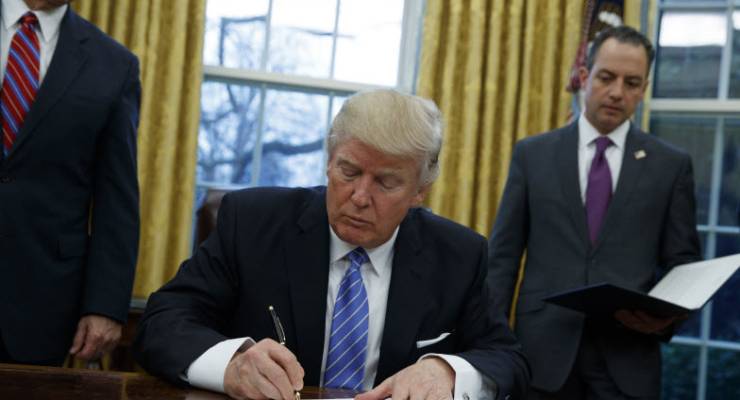
The US Supreme Court will hear arguments for and against US President Donald Trump’s Muslim travel ban in October, and a modified version of the ban will be implemented between now and then. Trump was ecstatic about the decision in a formal statement hailing the decision as a “clear victory” for national security. But it’s only the latest salvo in a back-and-forth war over the proposed ban. Here is the story so far:
December 7, 2015: Donald Trump calls for Muslims to be blocked from entering the US
A statement during Trump’s campaign is released titled, “Donald J. Trump Statement on Preventing Muslim Immigration”. The press release calls for a “total and complete shutdown of Muslims entering the United States”.
January 27, 2017: Trump issues first travel ban order
Trump issues an executive order banning citizens from Iran, Iraq, Yemen, Sudan, Somalia, Libya and Syria from entering the US for 90 days. The order would also block Syrian refugees indefinitely. Protests erupt in airports throughout the country as travelers were turned away from flights not knowing when they would see their families again.
January 28-29, 2017: Federal judges block travel ban
Federal judge Ann M. Donnelly in New York blocks part of the order citing it violates “rights to due process and equal protection guaranteed by the United States constitution”. The next day another federal judge, this time in Massachusetts, also blocks part of the order, saying the government could not “detain or remove” citizens who had legally arrived from the list of countries in Trump’s order.
January 30, 2017: Barack Obama slams travel ban
Former president Barack Obama breaks his silence for the first time since leaving office, praising the efforts of protesters to speak out against Trump’s order. Obama’s official spokesman says: “The president fundamentally disagrees with the notion of discriminating against individuals because of their faith or religion.”
January 30, 2017: Trump fires acting attorney-general Sally Yates
Acting attorney-general Sally Yates is fired after she told Justice Department lawyers not to defend the President’s order. The White House condemns Yates’ action, saying she “betrayed” the department, which was trying to “protect the citizens of the United States.”
February 2, 2017: Travel ban restrictions loosened
The Trump administration allows permanent residents deemed to be low-risk to apply to re-enter the country. After declaring the order would not be changed, the administration retreats with the ban no longer affecting green card holders.
February 9, 2017: Ban can’t be reinstated
A unanimous three-judge ruling denies Trump’s executive order, meaning citizens from the seven countries can continue to travel to and from the US. A furious Trump takes to Twitter to vent his anger.
March 6, 2017: Trump signs a revised executive order
A revised, six-nation order is signed, removing language that seemed to be targeting Muslims and removing Iraq from the original list of seven countries. The new order will take effect in 10 days’ time. Activists are still outraged, vowing to challenge the second order.
March 15, 2017: Travel ban blocked again
Federal judges in Hawaii and Maryland rule against the revised order, temporarily preventing the main restrictions of the new ban to come into effect.
March 29, 2017: Blocking of ban extended
The same federal judge in Hawaii grants the extension of ruling against the travel ban concluding the order discriminated against Muslims and would affect the state’s tourism industry. The Trump administration argues the travel ban is in the interest of protecting national security.
June 12, 2017: Courts uphold ruling against ban
The Ninth Circuit Appeals Court announces that the injunction on the second travel ban will remain. The decision came with a temporary restraining order placed on the iteration filed by the state of Hawaii. “The president must make a sufficient finding that the entry of these classes of people would be ‘detrimental to the interests of the United States,” the ruling states. Trump again takes to Twitter to vent his frustration.
June 27, 2017: Supreme Court weighs in
A Supreme Court ruling overturns objections from previous Federal Court decisions allowing a modified travel ban to be implemented. The Supreme Court decision means most of the ban’s provisions will go ahead until October, when the court will hear arguments. The ban does not apply to those with a “credible claim of a bona fide relationship with a person or entity in the United States”. The court meeting in October will weigh the president’s legal authority to apply national security restrictions against protecting individuals from discrimination based on religious beliefs or place of origin. Trump praises the Supreme Court for their decision via Twitter.
The travel ban will expire on September 27, with the court to hear the full case in October. What is clear is that this saga is not finished just yet.








Crikey is committed to hosting lively discussions. Help us keep the conversation useful, interesting and welcoming. We aim to publish comments quickly in the interest of promoting robust conversation, but we’re a small team and we deploy filters to protect against legal risk. Occasionally your comment may be held up while we review, but we’re working as fast as we can to keep the conversation rolling.
The Crikey comment section is members-only content. Please subscribe to leave a comment.
The Crikey comment section is members-only content. Please login to leave a comment.